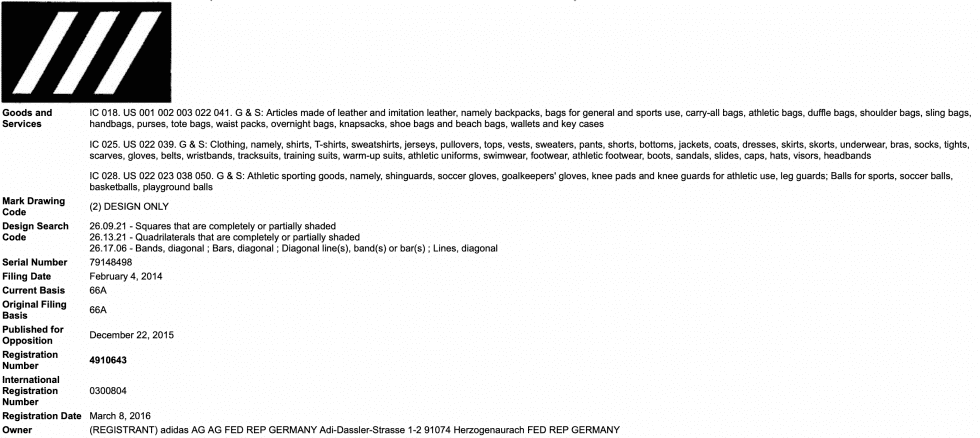A magistrate judge says that a counterclaim lodged by Thom Browne in the case filed against it by adidas for allegedly infringing one of the German sportswear giant’s three-stripe trademarks should be tossed out. According to a newly-filed recommendation and report, Magistrate Judge Robert Lehrburger of the U.S. District Court for the Southern District of New York states that Thom Browne has failed to assert a plausible claim that adidas’ Three-Quadrilaterals trademark is aesthetically functional (and thus, should be invalidated), and as a result, Judge Jed Rakoff should dismiss the counterclaim, and at the same time, strike two of the affirmative defenses that Thom Browne raised in response to adidas’ suit.
In his September 21 recommendation and report, Magistrate Judge Lehrburger sets the stage by distinguishing the two brands at play. Adidas is “a clothing company famous for its activewear and accessories,” the judge asserts, and citing Thom Browne’s counterclaim, states that adidas is also known for its “overzealous enforce[ment] of its actual and perceived rights in its ‘Three-Stripe mark.’” Thom Browne, on the other hand, is a “clothing and accessories” company, whose offerings are “sold for several hundred to several thousand dollars per garment,” “known for their tailoring and craftsmanship,” and “recognized through Thom Browne’s signature four-band design.”
Adidas first filed its suit in June 2021, alleging that Browne has “encroached into direct competition with adidas by offering sportswear and athletic-styled footwear that bear confusingly similar imitations” of adidas’s three-stripe mark. In response to adidas’ suit, Browne lodged an answer and counterclaim seeking cancellation of adidas’ Three-Quadrilaterals trademark registration (No. 4,910,643) on grounds of aesthetic functionality.
Three Stripes & Aesthetic Functionality
For some background: Supreme Court precedent states that aesthetic functionality arises when protection of a purported proprietary mark would ″put competitors at a significant non-reputation related disadvantage.″ In practice, Finnegan’s B. Brett Heavner has stated that the doctrine arises: “(a) when an asserted mark … does not actually identify the source of the products (traditional aesthetic functionality), or (b) when [an] asserted mark is protected, but a defendant has allegedly not infringed because it is only using the mark aesthetically and not as a source identifier (defensive aesthetic functionality).”
In the case at hand, Browne argues that trademark protection for adidas’ Three-Quadrilaterals mark puts competitors at “a significant non-reputation-related disadvantage,” given that the registration “is not limited to any specific number or orientation of stripes,” and thus, its registration for the mark should be cancelled. In furtherance of its counterclaim, Browne alleges that “adidas is asserting its registered trademark against Thom Browne’s use of four horizontal, parallel bands,” and thus, is “admit[ting] that its Three Quadrilaterals [mark] is not limited to a diagonal orientation or to three stripes.” Building on that assertion, the magistrate judge states that “Thom Browne alleges that if clothing designers were not permitted to use parallel stripes on clothing,” they would be put at a significant disadvantage.

However, Thom Browne gets it wrong on this front, the Magistrate Judge says. Instead of asserting a plausible claim that adidas’ three-stripe Quadrilaterals mark is aesthetically functional, such as by claiming that “the use of three parallel stripes – the subject of the challenged registration – is ‘essential to effective competition in a particular market,’” the brand “impermissibly attempts to transform an infringement argument into an invalidity argument.”
Specifically, the magistrate states that Browne “premises its aesthetic functionality claim on the fact that adidas claims infringement of the challenged registration: ‘Because adidas is asserting this registered trademark in this litigation against Thom Browne’s use of four horizontal, parallel bands, adidas admits that its Three Quadrilaterals [mark] is not limited to a diagonal orientation or to three stripes.’” Accordingly, the magistrate judge finds that “the fact that Thom Browne’s use of its Four Band Design on athletic clothing may, if proven, infringe adidas’ Three Stripe Mark as reflected in the challenged registration says nothing about whether the registration itself is limited to three stripes, which it clearly is.”
The Risk for Thom Browne
As for why Browne crafted its argument in this way, the magistrate judge has a theory (as first pointed out by adidas). It appears, Lehrburger states, that Thom Browne intentionally avoided claiming that adidas is putting competitors at a significant disadvantage by way of its exclusive rights in the Three-Stripe mark as embodied in the challenged Three Quadrilaterals because Thom Browne, itself, asserts that it has trademark rights in a multi-striped mark, “the Four Banded Design; namely, four horizontal parallel bands on a wide variety of clothing.”
Were Browne to successfully argue that adidas Three-Stripe mark puts competitors at a significant disadvantage so as to render the mark unprotectable, that “would be an implicit admission that its own trademark was subject to invalidation on grounds of aesthetic functionality,” Lehrburger contends. “Accordingly, rather than focusing on the trademark that is the subject of [adidas’ Three Quadrilaterals registration], Thom Browne grounds its aesthetic functionality argument on the use of parallel stripes on clothing generally.”
While that may have helped the brand to avoid shooting itself in the foot in terms of its own four-stripe mark, it ultimately prompted the magistrate judge to determine that it has failed to assert a plausible claim that adidas’ Three Quadrilaterals registration is invalid as aesthetically functional, and thus, its counterclaim should be dismissed for failure to state a claim.
The case is adidas America, Inc., et al., v. Thom Browne, Inc., 1:21-cv-05615 (SDNY).











